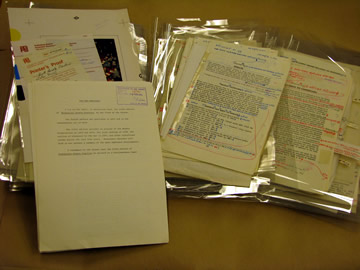170 Amendments after tabling
Amendments not altering the substance of the document may be made, and clerical or typographical errors may be corrected, by authority of the President, in a document that has been ordered to be printed. No other amendments may be made except by authority of the Senate.
Amendment history
Adopted: 15 March 1977, J.21 –22, as SO 365A
1989 revision: Old SO 365A renumbered as SO 170; terminology clarified by replacing “Amendments of a formal or verbal nature” with “Amendments not altering the substance of the document”
Commentary

J.R. Odgers, Clerk of the Senate 1965-79 and author of the first six editions of Australian Senate Practice
The genesis of this standing order was a dispute over alterations made to the 5th edition of Australian Senate Practice after it had been tabled and before it was printed as a Parliamentary Paper. On 10 November 1976, questions without notice on the issue were put to the President who later made a statement to the Senate, including a response by then Clerk of the Senate, Jim Odgers. It transpired that the document had been further edited before going to print. As with past editions, it was Odgers’ usual practice to update the work with current precedents and to modify language to better elaborate meaning. However, the integrity of the document remained unchanged.[1]
This raised a further question that magnified the procedural dilemma created by the absence of authority for routine amendment of a tabled document; namely, whether altering a document after tabling, substantively or otherwise, contravened the order for printing of the document.
The Standing Orders Committee considered these matters and concluded that there was no malpractice involved in the printing of the fifth edition of Australian Senate Practice.[2] Noting the bigger issue, however, that there was no procedure for amending documents, the committee recommended that a standing order similar to SO 124 (corrections to bills) be adopted to address this deficiency, which had existed unnoticed for three quarters of a century.[3]
During the Senate’s consideration of the committee’s report a motion was put to adopt the following new SO 365A:
Amendments of a verbal or formal nature may be made, and clerical or typographical errors may be corrected, by authority of the President, in a paper that has been ordered to be printed. No other amendments may be made except by authority of the Senate.[4]
Senator Cavanagh expressed reservations about the terms “verbal” and “formal” in the proposed new standing order, arguing that such amendments could lead to substantive changes, any of which would be likely to be open to differences of interpretation. Discussion followed about the scope of amendments permissible under the proposed standing order and Senator Chaney (Lib, WA) explained that it was intended to cover corrections of misused words or grammatical errors, and rectification of structural issues that were consequential on other minor textual changes.[5] Alterations beyond these would need to be considered by the Senate as a whole. The Senate resolved to adopt the new SO 365A as moved.

Discrepancies between the tabled and printed version of the 5th edition of Australian Senate Practice led to the adoption of SO 170

Proofs of the 5th edition tabled in the Senate
The 1989 revision of standing orders saw the potentially ambiguous terms “verbal” and “formal” replaced with the much clearer “Amendments not altering the substance of the document”.
Although the standing order provides that the President may authorise minor corrections to documents that have been ordered to be printed, current practice favours recourse to the authority of the Senate, whereby amendments to documents (in the form of errata or corrigenda) are tabled and motions to print them are moved accordingly. This practice has avoided contention and enhanced transparency.